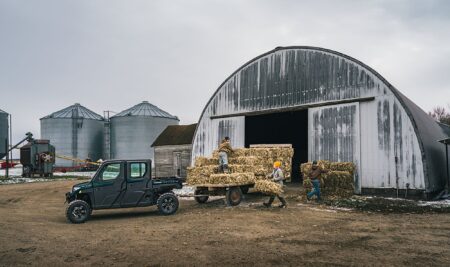According to the USDA’s Crop Progress report released May 5, corn planting progress in the Badger State is behind average, but progress for soybeans is ahead. Here’s a closer look at the numbers and some boots-on-the-ground perspective from an agronomist.
Corn Planting and Emergence
As of the latest numbers from USDA, corn planting in Wisconsin jumped 12 percentage points the week ending May 4, reaching 16%. Despite the double-digit increase, that’s still 5 points behind the five-year average.
During the first part of the week, growers in the southern half of the state were able to take advantage of dry conditions to get a lot of their corn crop in the ground, Syngenta Agronomist Nick Groth said.
Conditions weren’t as favorable farther north, though. “Unfortunately, the northern half of Wisconsin was hit by pretty substantial rainfall, of up to 1.5 inches in areas, on April 28,” Groth said earlier this week, on Monday. “This, combined with [it] being wetter to begin with — along with another shot of rain on Thursday and cooler temperatures — meant very little field activity occurred in northern Wisconsin last week,” he said.
USDA hasn’t reported any corn emergence for Wisconsin yet, but Groth reported the first of the season.
“The earliest planted corn fields are now emerging in southern Wisconsin,” Groth said on Monday. “With warm and sunny weather in the forecast, I would expect to see many of the fields planted over the last few weeks to be emerging by the end of the week,” he added.
Groth anticipated those favorable conditions for all of Wisconsin. “The forecast looks dry and sunny for northern Wisconsin as well, so I expect it to be a big week for field activity statewide,” he said.
Soybean Planting and Emergence
Corn planting may be behind average in the Badger State, but soybean planting is ahead of the curve. USDA said 17% of the crop was in the ground by May 4, 3 percentage points ahead of the five-year average.
Groth said soybean planting progress, like that of corn, is split across his state. Little progress was made in the north the week that ended May 4, but “there are pockets where growers planted some acres earlier in April,” Groth said.
Wisconsin’s soybean emergence hit 1% the week that ended May 4, according to USDA, which is untypical — the five-year average is 0%.
“I have not seen any soybeans emerged yet, but I suspect there are a few fields out there that have emerged. I would guess the early April planted beans will be emerging today,” he said on Monday, “and many bean fields in southern Wisconsin will be up by the end of the week.”
Grower Sentiment and Concerns
Groth said farmers in southern Wisconsin seem to be right on track and are “happy with the planting progress they have made.” On the other hand, northern Wisconsin growers “may be starting to get a little frustrated with the lack of productive days” they’ve had. Despite that, Groth said it’s not a significant delay and the upcoming forecast “looks promising for fieldwork over the next week.”
While planting progress may not be significantly delayed, weed control is becoming an area of concern. “Wind has been a major issue around Wisconsin [this] spring, making it difficult for growers to apply critical pre-emerge residual herbicide applications,” Groth said. One result of the delay is that he’s already seen waterhemp emergence in southern Wisconsin, which is “a good 10 days ahead of expected for waterhemp emergence in that area,” according to Groth.
Courtesy of Syngenta Agronomist Nick Groth
In response, Groth has been talking strategy with growers. “If soybeans emerge soon, this may end up limiting which products growers are able to apply for residual weed control. We have had many conversations around switching to more flexible residual soybean herbicides over the last week,” he said.


:max_bytes(150000):strip_icc()/WheatField-CloseUp-2000-bc79406da4004a2d94bcb2c32153cc3a.jpg)
:max_bytes(150000):strip_icc()/102382793_soybeans-1a81c6603895423a8c6518aeefaa2b19.jpg)
:max_bytes(150000):strip_icc()/48671043887_7bb824daff_o-ea6663a7cacb4a7fa70d7b9a5af1f1fa.jpg)


:max_bytes(150000):strip_icc()/100126274_corn-3c1d42dd56254c0d9269e5f58ed3b96a.jpg)


:max_bytes(150000):strip_icc()/WebMedium_JPG-2025-orv-family-image-00307-27c767eba092415c9f7b4751603e7840.jpg)